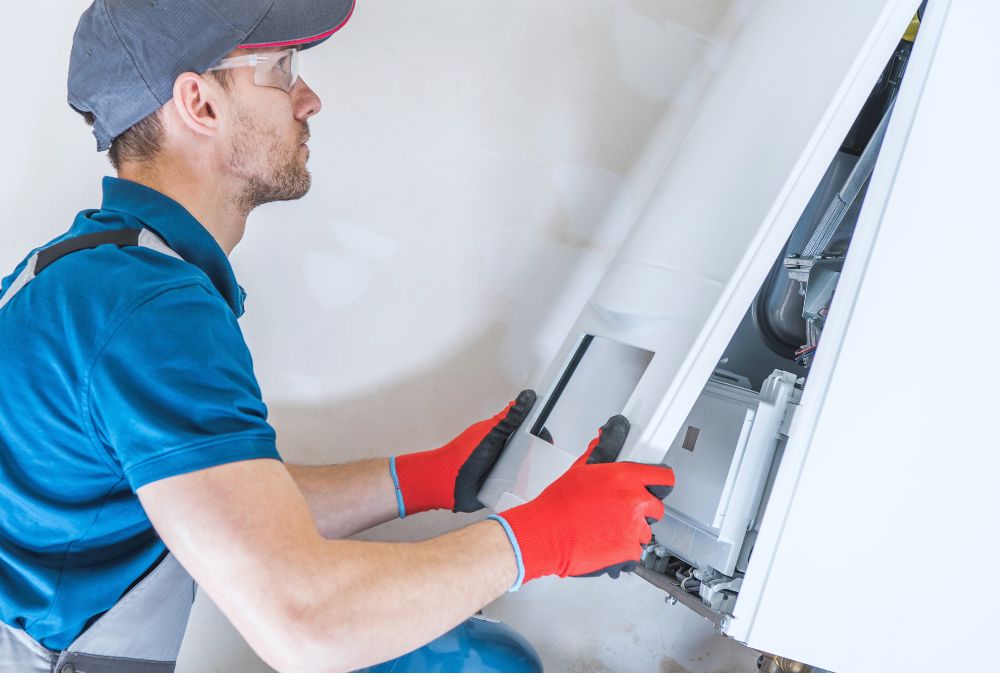Installing a furnace is one of the most important upgrades you can make for comfort and safety in your home. But when it’s not handled correctly, problems quickly surface like higher energy bills, uneven heating, or even safety hazards. Many of these issues come from common furnace install errors that could have been avoided with proper planning and professional expertise.
At Leaps & Bounds HVAC, we’ve seen how small oversights during installation can snowball into major headaches. Here’s how to identify and prevent the mistakes that put your comfort, safety, and wallet at risk.
How Improper HVAC Practices Cause Long-Term Problems
Improper HVAC practices during installation are more than just inconvenient, they directly affect comfort, efficiency, and safety. A poorly installed furnace often leads to:
- Inconsistent heating across rooms
- Shortened system lifespan
- Frequent repair needs
- Higher monthly energy costs
These outcomes usually stem from cutting corners during the installation process. When connections aren’t secured, venting is misaligned, or wiring isn’t handled properly, the system simply can’t perform the way it should. Over time, the home feels less comfortable, and repair bills pile up.

The best way to avoid these headaches is to work with certified HVAC professionals who understand local codes and the unique demands of Harrisburg homes. A professional approach means every unit is installed correctly, safety checks are completed, and your system is prepared for years of dependable performance.
Why Accurate Load Calculation Matters
Choosing the right furnace is about making sure it fits your home’s exact needs. That’s where load calculation comes in. This process accounts for:
- Square footage and ceiling height
- Insulation levels and window size
- Ductwork condition and layout
- Typical outdoor temperatures in Harrisburg
When load calculation is skipped or done incorrectly, the furnace is either too big or too small. An oversized furnace cycles on and off too often, wasting energy and wearing out parts. An undersized unit runs constantly, struggling to keep up while driving up utility costs.
Local HVAC experts know how to balance these factors for Pennsylvania homes, ensuring your furnace delivers steady heat, keeps filters cleaner, and reduces the strain on fans and other components. Proper calculation up front protects your investment and avoids the discomfort of hot-and-cold spots throughout the house.
For homeowners, understanding the basics of load calculation also provides peace of mind. Asking your installer how they calculated furnace size is a good practice. They should be able to explain how insulation, window quality, and duct condition affect the final choice. This transparency shows that your system is being sized thoughtfully, rather than relying on guesswork.
Spotting the Signs of an Improperly Installed Furnace
Even after installation, it’s possible to tell whether something was missed. Recognizing the early warning signs of an improperly installed furnace can save you from ongoing repair costs.
Red flags to watch for include:
- Air filters clogging unusually fast
- Fans running constantly or at odd intervals
- Uneven heating between rooms
- Strange noises such as rattling, buzzing, or whistling
- Unexpectedly high energy bills
These symptoms suggest the system wasn’t installed with proper balance, alignment, or airflow considerations. Acting quickly, by calling in a trusted HVAC contractor, prevents minor issues from turning into costly replacements.
For Harrisburg homeowners, local professionals can evaluate the setup, correct installation errors, and restore efficiency before permanent damage occurs.
How Certified Professionals Prevent Common Furnace Errors
The difference between a smooth installation and years of problems often comes down to who installs the system. Certified specialists are trained to avoid the missteps that lead to common furnace install errors, such as:
- Poor thermostat placement that confuses temperature readings
- Loose electrical connections that create hazards
- Incorrect venting that traps dangerous gases
- Neglected duct sealing that causes heat loss
By paying close attention to every connection, seal, and setting, a professional installer makes sure your furnace runs efficiently from day one. Certified experts also review warranties, ensure safety standards are met, and provide clear guidance on maintenance. This approach gives homeowners confidence that their furnace will perform safely and consistently all winter long.
Preparing for a Safe and Reliable Installation in Harrisburg
Avoiding mistakes starts with preparation. As a homeowner, you can support a safe installation by:
- Clearing access to the furnace location and electrical panels
- Discussing your comfort goals with the installer in advance
- Asking about load calculation and system sizing
- Scheduling routine maintenance immediately after installation
A detailed checklist is also a powerful tool for staying organized. At Leaps & Bounds, we provide a practical guide that covers everything from workspace preparation to filter replacement reminders. These small steps reduce the chance of overlooked details and keep your new system running efficiently.
It also helps to think ahead about the long term. Make a plan for seasonal inspections, set calendar reminders for filter changes, and budget for yearly professional tune-ups. Being proactive keeps your HVAC system in top condition and extends the lifespan of your furnace. By taking these extra steps, you’ll not only avoid common installation errors but also build a reliable routine for long-term comfort.
Ready to Avoid Common Furnace Installation Errors?
Installing a furnace the right way means fewer repairs, lower bills, and safer winters for your family. Don’t let poor installation create lasting problems in your home. Trust the team at Leaps & Bounds HVAC for precise installation, honest recommendations, and long-term support.
Contact us today to schedule your furnace consultation in Harrisburg, PA, and take the first step toward reliable heat and year-round comfort.


